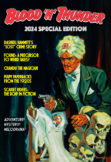EDitorial Comments
More on “10-20-30” Melodrama
In addition to providing visceral thrills, 10-20-30 “mellers” regularly trafficked in narrative devices that would later be incorporated into motion-picture serials. They often revolved around a struggle for vitally important papers: the map to hidden wealth, the deed to a home, the will to an estate, the plans to an invention, the confession to a crime, the bill-of-sale for disputed property, or the birth certificate establishing parentage of a character whose fate was tied to his or her ancestry. In a chapter play, any document of that type might serve as what Pearl White termed “the weenie” and what Alfred Hitchcock later called “the MacGuffin.”
Another plot catalyst carried over from stage to film was the sudden death, disgrace or disappearance of a father, which forced his dutiful daughter to undertake arduous or unpleasant tasks. Like their 10-20-30 counterparts, the heroines of motion-picture serials always rose to the challenges presented them, invariably completing their missions, defeating their opponents, and triumphing over adversity.
Today, many people associate the word “melodrama” with post-World War II stories of domestic travail involving repressed or unfulfilled housewives. But during the 10-20-30 era it was used to describe overwrought plots and exaggerated situations. Suspense and sensation were the currency of these blood-and-thunder epics, which consciously downplayed emotional nuance in favor of externalized action. Reducing the dramatis personae to stereotypes was essential to maintaining narrative speed and clarity. Character delineation was always sublimated to physical action.
Like the silent serials, 10-20-30 mellers were ground out like sausages and seldom strayed from the well-established recipe. To practitioners of the form, ingenuity was defined as a writer’s ability to mix standard ingredients skillfully enough to create the illusion that spectators were being served something new. In another parallel to chapter plays (especially those of the Twenties), 10-20-30 melodramas were produced on fairly rigid budgets. Experienced theater owners knew almost to the seat how many local patrons could be coaxed to attend each new production, so any half-decent play that stuck to its budget was assured of turning a profit.
Ten-twenty-thirty melodrama offered carefully measured rations of comedy and pathos but emphasized nail-biting suspense and surprisingly vigorous, elaborately staged action. Iconic images associated with early serials — the heroine tied to railroad tracks, bound to a log sliding toward a buzz saw, or dangling from frayed ropes above deep pits and deathtraps — actually derive from scenes in famous 10-20-30 productions. The stagecraft behind these shows was remarkably sophisticated for its time, especially once electrical devices made certain illusions easier to create.
The sensational stage melodrama perished for one simple reason: money. During the 20th century’s early years, 10-20-30 admission prices gradually crept up to 25-50-75, keeping pace with rising production costs. But nickelodeons and other venues featuring motion pictures were charging five to ten cents for several reels of entertainment. Since melodrama was a staple of early motion pictures, it was inevitable that thrill-hungry, working-class patrons would forsake the more expensive vehicle for the cheaper one. Moreover, it was a logical choice. Narrative silent film, dominated in the waning years of 10-20-30 by one-reelers, was the perfect medium for stories built around easily identifiable character types and visual thrills. Realism was an additional inducement: movie horses did not run on treadmills and fire scenes could be staged without resorting to camouflaged smoke pots.
Popular-priced stage melodrama had already passed from the American pop-culture scene by 1914, when Pearl White’s Pauline faced her first perils. It disappeared from the pop-culture landscape with amazing rapidity — almost overnight, in fact. But filmmakers made celluloid adaptations of 10-20-30 warhorses throughout the silent years and even into the early talkie period.
Recent Posts
- Windy City Film Program: Day Two
- Windy City Pulp Show: Film Program
- Now Available: When Dracula Met Frankenstein
- Collectibles Section Update
- Mark Halegua (1953-2020), R.I.P.
Archives
- March 2023
- July 2021
- May 2021
- March 2020
- February 2020
- December 2019
- November 2019
- October 2019
- September 2019
- August 2019
- May 2019
- April 2019
- March 2019
- February 2019
- December 2018
- November 2018
- October 2018
- August 2018
- June 2018
- February 2018
- December 2017
- October 2017
- September 2017
- August 2017
- May 2017
- April 2017
- February 2017
- September 2016
- August 2016
- July 2016
- June 2016
- November 2015
- October 2015
- September 2015
- August 2015
- July 2015
- June 2015
- May 2015
- April 2015
- March 2015
- February 2015
- January 2015
- August 2014
- July 2014
- June 2014
- May 2014
- April 2014
- January 2014
- December 2013
- September 2013
- August 2013
- July 2013
- June 2013
- May 2013
- April 2013
- March 2013
- February 2013
- January 2013
- December 2012
- October 2012
- September 2012
- August 2012
- July 2012
- June 2012
- May 2012
Categories
- Birthday
- Blood 'n' Thunder
- Blood 'n' Thunder Presents
- Classic Pulp Reprints
- Collectibles For Sale
- Conventions
- Dime Novels
- Film Program
- Forgotten Classics of Pulp Fiction
- Movies
- Murania Press
- Pulp People
- PulpFest
- Pulps
- Reading Room
- Recently Read
- Serials
- Special Events
- Special Sale
- The Johnston McCulley Collection
- Uncategorized
- Upcoming Books
- Western Movies
- Windy City pulp convention
Dealers
Events
Publishers
Resources
- Coming Attractions
- Field Guide to Wild American Pulp Artists
- MagazineArt.Org
- Mystery*File
- ThePulp.Net




